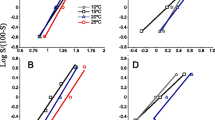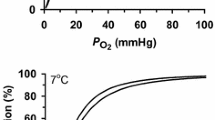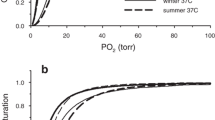Abstract
Tunas (family Scombridae) are exceptional among most teleost fishes in that they possess vascular heat exchangers which allow heat retention in specific regions of the body (termed ‘regional heterothermy’). Seemingly exclusive to heterothermic fishes is a markedly reduced temperature dependence of blood–oxygen (blood–O2) binding, or even a reversed temperature dependence where increasing temperature increases blood–O2 affinity. These unusual binding properties have been documented in whole blood and in haemoglobin (Hb) solutions, and they are hypothesised to prevent oxygen loss from arteries to veins within the vascular heat exchangers and/or to prevent excessive oxygen unloading to the warm tissues and ensure an adequate supply of oxygen to tissues positioned efferent to the heat exchangers. The temperature sensitivity of blood–O2 binding has not been characterised in an ectothermic scombrid (mackerels and bonitos), but the existence of the unusual binding properties in these fishes would have clear implications for their proposed association with regional heterothermy. Accordingly, the present study examined oxygenation of whole blood of the chub mackerel (Scomber japonicus) at 10, 20 and 30°C and at 0.5, 1 and 2% CO2. Oxygen affinity was generally highest at 20°C for all levels of CO2. Temperature-independent binding was observed at low (0.5%) CO2, where the PO2 at 50% blood–O2 saturation (P 50) was not statistically different at 10 and 30°C (2.58 vs. 2.78 kPa, respectively) with an apparent heat of oxygenation (∆H°) close to zero (−6 kJ mol−1). The most significant temperature-mediated difference occurred at high (2%) CO2, where the P 50 at 10°C was twofold higher than that at 20°C with a corresponding ∆H° of +43 kJ mol−1. These results provide clear evidence of independent and reversed open-system temperature effects on blood oxygenation in S. japonicus, and it is therefore speculated that these unusual blood–O2 binding characteristics may have preceded the evolution of vascular heat exchangers and regional heterothermy in fishes.



Similar content being viewed by others
References
Andersen ME, Olson JS, Gibson QH, Carey FG (1973) Studies on ligand binding to hemoglobins from teleosts and elasmobranchs. J Biol Chem 248:331–341
Berenbrink M, Koldkjaer P, Kepp O, Cossins AR (2005) Evolution of oxygen secretion in fishes and the emergence of a complex physiological system. Science 307:1752–1757
Bernal D, Sepulveda CA (2005) Evidence for temperature elevation in the aerobic swimming musculature of the common thresher shark, Alopias vulpinus. Copeia 2005;146–151
Bernal D, Dickson KA, Shadwick RE, Graham JB (2001) Analysis of the evolutionary convergence for high performance swimming in lamnid sharks and tunas. Comp Biochem Physiol A Mol Integr Physiol 129:695–726
Block BA, Finnerty JR (1994) Endothermy in fishes—a phylogenetic analysis of constraints, predispositions, and selection pressures. Environ Biol Fishes 40:283–302
Block BA, Dewar H, Blackwell SB, Williams TD, Prince ED, Farwell CJ, Boustany A, Teo SLH, Seitz A, Walli A, Fudge D (2001) Migratory movements, depth preferences, and thermal biology of Atlantic bluefin tuna. Science 293:1310–1314
Boutilier RG, Aughton P, Shelton G (1984) O2 and CO2 transport in relation to ventilation in the Atlantic mackerel, Scomber scombrus. Can J Zool 62:546–554
Brauner CJ, Thorarensen H, Gallaugher P, Farrell AP, Randall DJ (2000) CO2 transport and excretion in rainbow trout (Oncorhynchus mykiss) during graded sustained exercise. Resp Physiol 119:69–82
Brill RW, Bushnell PG (1991) Effects of open- and closed-system temperature changes on blood oxygen dissociation curves of skipjack tuna, Katsuwonus pelamis, and yellowfin tuna, Thunnus albacares. Can J Zool 69:1814–1821
Brill RW, Bushnell PG (2006) Effects of open- and closed-system temperature changes on blood O2-binding characteristics of Atlantic bluefin tuna (Thunnus thynnus). Fish Physiol Biochem 32:283–294
Caldwell S, Rummer JL, Brauner CJ (2006) Blood sampling techniques and storage duration: effects on the presence and magnitude of the red blood cell β-adrenergic response in rainbow trout (Oncorhynchus mykiss). Comp Biochem Physiol A Mol Integr Physiol 144:188–195
Carey FG (1973) Fishes with warm bodies. Sci Amer 228:36–44
Carey FG, Lawson KD (1973) Temperature regulation in free-swimming bluefin tuna. Comp Biochem Physiol A Comp Physiol 44:375–392
Carpenter KE, Collette BB, Russo JL (1995) Unstable and stable classifications of scombroid fishes. Bull Mar Sci 56:379–405
Cech JJ, Laurs RM, Graham JB (1984) Temperature-induced changes in blood gas equilibria in the albacore, Thunnus alalunga, a warm-bodied tuna. J Exp Biol 109:21–34
Clark TD, Eliason EJ, Sandblom E, Hinch SG, Farrell AP (2008a) Calibration of a hand-held haemoglobin analyser for use on fish blood. J Fish Biol 73:2587–2595
Clark TD, Seymour RS, Wells RMG, Frappell PB (2008b) Thermal effects on the blood respiratory properties of southern bluefin tuna, Thunnus maccoyii. Comp Biochem Physiol A Mol Integr Physiol 150:239–246
Collette BB, Nauen CE (1983) FAO species catalogue, vol. 2. Scombrids of the world. An annotated and illustrated catalogue of tunas, mackerels, bonitos and related species known to date. FAO Fish Synop 125:1–137
Collette BB, Reeb C, Block BA (2001) Systematics of the tunas and mackerels (Scombridae). In: Block BA, Stevens ED (eds) Tuna: physiology, ecology, and evolution, vol. 19. Fish physiology. Academic Press, San Diego, pp 1–33
Dickson KA (1994) Tunas as small as 207 mm fork length can elevate muscle temperatures significantly above ambient water temperature. J Exp Biol 190:79–93
Dickson KA (1996) Locomotor muscle of high performance fishes—what do comparisons of tunas with ectothermic sister taxa reveal? Comp Biochem Physiol A Mol Integr Physiol 113:39–49
Dickson KA, Graham JB (2004) Evolution and consequences of endothermy in fishes. Physiol Biochem Zool 77:998–1018
Fudge DS, Stevens ED (1996) The visceral retia mirabilia of tuna and sharks: an annotated translation and discussion of the Eschricht and Müller 1835 paper and related papers. Guelph Ichthyol Rev 4:1–53
Graham JB (1973) Heat exchange in the black skipjack, and the blood–gas relationship of warm-bodied fishes. Proc Nat Acad Sci USA 70:1964–1967
Graham JB, Dickson KA (2000) The evolution of thunniform locomotion and heat conservation in scombrid fishes: new insights based on the morphology of Allothunnus fallai. Zool J Linn Soc 129:419–466
Graham JB, Dickson KA (2004) Tuna comparative physiology. J Exp Biol 207:4015–4024
Greer-Walker M, Pull GA (1975) A survey of red and white muscle in marine fish. J Fish Biol 7:295–300
Gunn J, Young J (1999) Environmental determinants of the movement and migration of juvenile southern bluefin tuna. In: Fish movement and migration. Australian Society for Fish Biology, pp 123–128
Hall FG, Gray IE (1929) The hemoglobin concentration of the blood of marine fishes. J Biol Chem 81:589–594
Herbert NA, Skov PV, Wells RMG, Steffensen JF (2006) Whole blood–oxygen binding properties of four cold-temperate marine fishes: blood affinity is independent of pH-dependent binding, routine swimming performance, and environmental hypoxia. Physiol Biochem Zool 79:909–918
Hernandez CJJ, Ortega SAT (2000) Synopsis of biological data on the chub mackerel (Scomber japonicus Houttuyn, 1782). In: FAO fisheries synopsis, vol 157, Rome, pp 1–77
Hughes GM (1966) The dimensions of fish gills in relation to their function. J Exp Biol 45:177–195
Jones DR, Brill RW, Mense DC (1986) The influence of blood gas properties on gas tensions and pH of ventral and dorsal aortic blood in free-swimming tuna, Euthynnus affinis. J Exp Biol 120:201–213
Kishinouye K (1923) Contributions to the comparative study of the so-called scombroid fishes. Tokyo Univ Coll Agric J 8:293–475
Klawe WL, Barrett IA, Klawe BMH (1963) Haemoglobin content of the blood of six species of scombroid fishes. Nature 198:96
Korsmeyer KE, Lai NC, Shadwick RE, Graham JB (1997) Oxygen transport and cardiovascular responses to exercise in the yellowfin tuna Thunnus albacares. J Exp Biol 200:1987–1997
Larsen C, Malte H, Weber RE (2003) ATP-induced reverse temperature effect in isohemoglobins from the endothermic porbeagle shark (Lamna nasus). J Biol Chem 278:30741–30747
Lowe TE, Brill RW, Cousins KL (2000) Blood oxygen-binding characteristics of bigeye tuna (Thunnus obesus), a high-energy-demand teleost that is tolerant of low ambient oxygen. Mar Biol 136:1087–1098
Lydeard C, Roe KJ (1997) The phylogenetic utility of the mitochondrial cytochrome b gene for inferring relationships among Actinopterygian fishes. In: Kocher TD, Stepien C (eds) Molecular systematics of fishes. Academic Press, San Diego, pp 285–303
Matsui T (1967) Review of the mackerel genera Scomber and Rastrelliger with description of a new species of Rastrelliger. Copeia 1967:71–83
Monsch KA (2006) A revision of scombrid fishes (Scombroidei, Perciformes) from the Middle Eocene of Monte Bolca, Italy. Paleontology 49:873–888
Naylor GJP, Martin AP, Mattison EG, Brown WM (1997) Interrelationships of lamniform sharks: testing phylogenetic hypotheses with sequence data. In: Kocher TD, Stepien C (eds) Molecular systematics of fishes. Academic Press, San Diego, pp 199–218
Randall DJ, Perry SF (1992) Catecholamines. In: Hoar WS, Randall DJ, Farrell AP (eds) The cardiovascular system, fish physiology, vol 12B. Academic Press, London, pp 255–300
Rasmussen JR, Wells RMG, Henty K, Clark TD, Brittain T (2009) Characterization of the hemoglobins of the Australian lungfish Neoceratodus forsteri (Krefft). Comp Biochem Physiol A Mol Integr Physiol 152:162–167
Reeves RB (1972) An imidazole alphastat hypothesis for vertebrate acid–base regulation: tissue carbon dioxide content and body temperature in bullfrogs. Resp Physiol 14:219–236
Roberts JL (1975) Active branchial and ram gill ventilation in fishes. Biol Bull 148:85–105
Roberts JL, Graham JB (1979) Effect of swimming speed on the excess temperatures and activities of heart and red and white muscles in the mackerel, Scomber japonicus. Fish Bull 76:861–867
Root RW (1931) The respiratory function of the blood of marine fishes. Biol Bull 61:427–456
Rossi-Fanelli A, Antonini E (1960) Oxygen equilibrium of haemoglobin from Thunnus thynnus. Nature 186:895–896
Runcie RM, Dewar H, Hawn DR, Frank LR, Dickson KA (2009) Evidence for cranial endothermy in the opah (Lampris guttatus). J Exp Biol 212:461–470
Schaefer KM (1986) Lethal temperatures and the effect of temperature change on volitional swimming speeds of chub mackerel, Scomber japonicus. Copeia 1986:39–44
Sepulveda C, Dickson KA (2000) Maximum sustainable speeds and cost of swimming in juvenile kawakawa tuna (Euthynnus affinis) and chub mackerel (Scomber japonicus). J Exp Biol 203:3089–3101
Sepulveda CA, Wegner NC, Bernal D, Graham JB (2005) The red muscle morphology of the thresher sharks (family Alopiidae). J Exp Biol 208:4255–4261
Sepulveda CA, Dickson KA, Frank LR, Graham JB (2007) Cranial endothermy and a putative brain heater in the most basal tuna species, Allothunnus fallai. J Fish Biol 70:1720–1733
Sepulveda CA, Dickson KA, Bernal D, Graham JB (2008) Elevated red myotomal muscle temperatures in the most basal tuna species, Allothunnus fallai. J Fish Biol 73:241–249
Shadwick RE (2005) How tunas and lamnid sharks swim: an evolutionary convergence. Am Sci 93:524–531
Steen JB, Berg T (1966) The gills of two species of haemoglobin-free fishes compared to those of other teleosts—with a note on severe anaemia in an eel. Comp Biochem Physiol 18:517–526
Tetens V, Lykkeboe G, Christensen NJ (1988) Potency of adrenaline and noradrenaline for beta-adrenergic proton extrusion from red cells of rainbow trout, Salmo gairdneri. J Exp Biol 134:267–280
Weber RE, Fago A (2008) Adaptive reduction in temperature dependence of hemoglobin–oxygen binding in a heterothermic fish (Blue marlin). Comp Biochem Physiol A Mol Integr Physiol 151:S52 (abstract)
Weber RE, Jensen FB (1988) Functional adaptations in hemoglobins from ectothermic vertebrates. Ann Rev Physiol 50:161–179
Weber RE, Behrens JW, Malte H, Fago A (2008) Thermodynamics of oxygenation-linked proton and lactate binding govern the temperature sensitivity of O2 binding in crustacean (Carcinus maenas) hemocyanin. J Exp Biol 211:1057–1062
Wells RMG, McIntyre RH, Morgan AK, Davie PS (1986) Physiological stress responses in big gamefish after capture: observations on plasma chemistry and blood factors. Comp Biochem Physiol A Mol Integr Physiol 84:565–571
Wells RMG, Baldwin J, Seymour RS (1997) Low concentrations of methaemoglobin in marine fishes of the Great Barrier Reef, Australia. Mar Fresh Res 48:303–309
Wells RMG, Baldwin J, Seymour RS, Baudinette RV, Christian K, Bennett MB (2003) Oxygen transport capacity in the air-breathing fish, Megalops cyprinoides: compensations for strenuous exercise. Comp Biochem Physiol A Mol Integr Physiol 134:45–53
Wood SC (1980) Adaptation of red blood cell function to hypoxia and temperature in ectothermic vertebrates. Am Zool 20:163–172
Acknowledgments
All field collections were conducted under the California Department of Fish and Game Scientific Collection Permit SCP-2471, the Pfleger Institute of Environmental Research Animal Care Protocol (#138-145-08), and the Animal Care and Use Committee of the University of Massachusetts, Dartmouth (#05-06). T. D. Clark was supported by a Killam Postdoctoral Fellowship. The research was supported by Natural Sciences and Engineering Research Council of Canada Discovery Grants to A. P. Farrell and C. J. Brauner. We thank Michael Berenbrink and David Randall for discussions relating to this work and for highlighting some important publications.
Author information
Authors and Affiliations
Corresponding author
Additional information
Communicated by I. D. Hume.
Rights and permissions
About this article
Cite this article
Clark, T.D., Rummer, J.L., Sepulveda, C.A. et al. Reduced and reversed temperature dependence of blood oxygenation in an ectothermic scombrid fish: implications for the evolution of regional heterothermy?. J Comp Physiol B 180, 73–82 (2010). https://doi.org/10.1007/s00360-009-0388-7
Received:
Revised:
Accepted:
Published:
Issue Date:
DOI: https://doi.org/10.1007/s00360-009-0388-7




